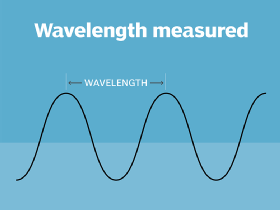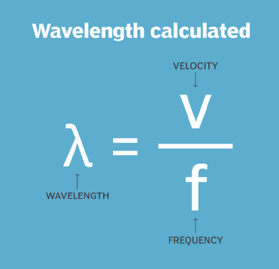What is wavelength?
Wavelength is the distance between identical points, or adjacent crests, in the adjacent cycles of a waveform signal propagated in space or along a wire.
In wireless systems, wavelength is usually specified in meters (m), centimeters (cm) or millimeters (mm). In the case of infrared (IR), visible light, ultraviolet (UV) and gamma radiation (γ), the wavelength is more often specified in nanometers (nm) or angstroms (Å). Nanometers are units of 10-9 m, and angstroms are units of 10-10 m.
Wavelength is inversely related to frequency, which refers to the number of wave cycles per second. The higher the frequency of the signal, the shorter the wavelength.
A sound wave is the pattern of disturbance caused by the movement of energy traveling through a medium, such as air, water or any other liquid or solid matter, as it propagates away from the source of the sound. A water wave is an example of a wave that involves a combination of longitudinal and transverse motions. Vibrations between an electric field and a magnetic field create an electromagnetic wave.
How to measure wavelength
Instruments such as optical spectrometers or optical spectrum analyzers can detect wavelengths in the electromagnetic spectrum.

Wavelengths are typically measured in the following units:
- Kilometers (km).
- Meters.
- Millimeters.
- Micrometers (μm).
- Nanometers.
- Picometers (pm).
- Femtometers (fm).
The latter unit is used to measure shorter wavelengths on the electromagnetic spectrum, such as UV radiation, X-rays and gamma rays. Conversely, radio waves have much longer wavelengths, reaching anywhere from 1 mm to 100 km, depending on the frequency.
The distance between repetitions in the waves indicates where the wavelength is on the electromagnetic radiation spectrum, which includes radio waves in the audio range and waves in the visible light range.

Wavelength formula
Divide the velocity of a wave by its frequency to calculate wavelength. This is often expressed as the equation seen here.
The Greek letter lambda λ represents wavelength, expressed in meters. The v is wave velocity, calculated as meters per second (m/s). And the f stands for frequency, which is measured in hertz (Hz).
For example, if f is the frequency of the signal as measured in megahertz (MHz), and λ is the wavelength as measured in meters, then:
λ = 300/f
and, conversely:
f = 300/λ
Wave division multiplexing
In the 1990s, fiber optic cable's ability to carry data was significantly increased with the development of wavelength-division multiplexing (WDM). AT&T's Bell Labs introduced this technique, which established a way to split a beam of light into different wavelengths that could travel through the fiber independent of one another. These optical networks are also called photonic networks because they use light to transmit data.
WDM, along with dense WDM (DWDM) and other methods, permits a single optical fiber to transmit multiple signals at the same time. As a result, existing optical networks gain increased capacity.
The three most common wavelengths in fiber optics are 850 nm, 1,300 nm and 1,550 nm.

Types of waveforms
Waveform describes the shape or form of a wave signal. Wave is typically used to describe an acoustic signal or cyclical electromagnetic signal because each is similar to waves in a body of water.
Four basic types of waveforms exist:
- Sine wave. The voltage increases and decreases in a steady curve. Sound waves, light waves and water waves all have sine waves. Additionally, the alternating current voltage provided in the public power grid is in the form of a sine wave.
- Square wave. The square wave represents a signal where voltage simply turns on, stays on for a while, turns off, stays off for a while and repeats. It's called a square wave because the graph of a square wave shows sharp, right-angle turns. Many electronic circuits have square waves.
- Triangle wave. The voltage increases in a straight line until it reaches a peak value, and then it decreases in a straight line. If the voltage reaches zero and starts to rise again, the triangle wave is a form of direct current (DC). However, if the voltage crosses zero and goes negative before it starts to rise again, the triangle wave is a form of alternating current (AC).
- Sawtooth wave. The sawtooth wave is a hybrid of a triangle wave and a square wave. In most sawtooth waves, the voltage increases in a straight line until it reaches its peak voltage, and then the voltage drops instantly -- or almost instantly -- to zero and repeats immediately.
Relationship between frequency and wavelength
Wavelength and frequency of light are closely related. The higher the frequency, the shorter the wavelength. The lower the frequency, the longer the wavelength. The energy of a wave is directly proportional to its frequency but inversely proportional to its wavelength. That means the greater the energy, the larger the frequency and the shorter the wavelength. Given the relationship between wavelength and frequency, short wavelengths are more energetic than long wavelengths.
Electromagnetic waves always travel at the same speed: 299,792 kilometers per second (km/s). In the electromagnetic spectrum, numerous types of waves exist with different frequencies and wavelengths. However, they're all related by one equation: The frequency of any electromagnetic wave multiplied by its wavelength equals the speed of light.
Wavelengths in wireless networks
Although frequencies are more commonly discussed in wireless networking, wavelengths are also an important factor in Wi-Fi networks. Wi-Fi operates at six frequencies, all in the gigahertz range: 2.4 GHz, 3.6 GHz, 4.9 GHz, 5 GHz, 5.9 GHz and 6 GHz. Higher frequencies have shorter wavelengths, and signals with shorter wavelengths have more trouble penetrating obstacles like walls and floors.
As a result, wireless access points that operate at higher frequencies -- with shorter wavelengths -- often consume more power to transmit data at similar speeds and distances achieved by devices that operate at lower frequencies -- with longer wavelengths.
Editor's note: This definition was updated by editors in 2024 to improve the reader experience.






